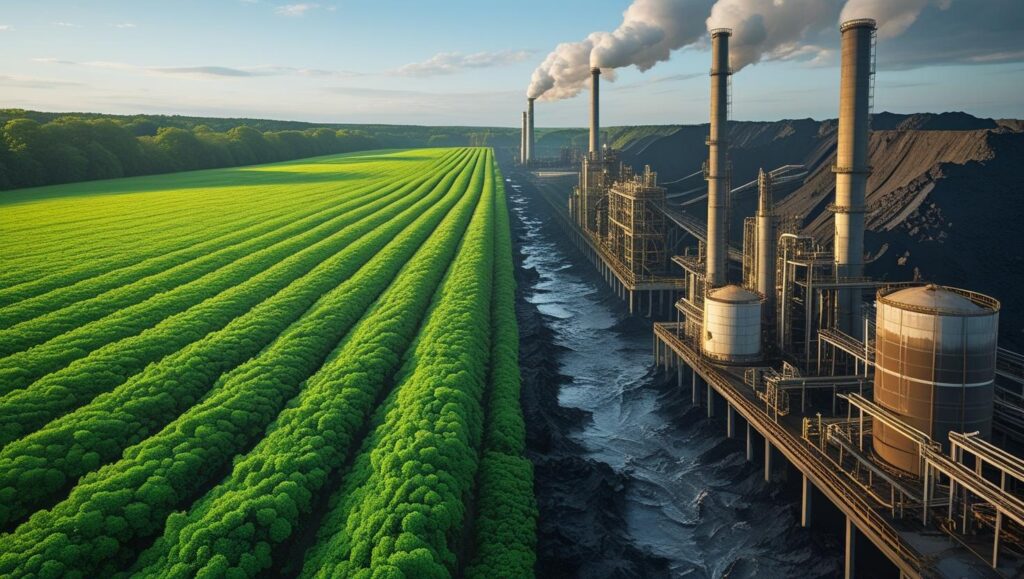Biomass vs. Fossil Fuels: Which Is Greener? – A Deep Dive into Sustainable Energy
The quest for sustainable energy solutions is at the forefront of global environmental discussions. As we grapple with climate change and diminishing natural resources, the choices we make about our energy sources become increasingly critical. Among the many alternatives, the debate often narrows down to two prominent contenders: biomass vs. fossil fuels. While fossil fuels have powered our world for centuries, their environmental toll is undeniable. Biomass, on the other hand, is frequently touted as a renewable and greener alternative. But is it truly as eco-friendly as it seems? This comprehensive guide will explore the intricacies of both energy sources, examining their environmental impact, efficiency, and role in shaping a more sustainable future.
Understanding the Basics: What Are They?
Before delving into the “greener” debate, it’s essential to understand what each energy source entails.
Fossil Fuels: The Legacy Energy Source
Fossil fuels are hydrocarbons, primarily coal, oil, and natural gas, formed from the remains of ancient plants and animals over millions of years. They are extracted from the Earth’s crust and burned to produce energy. Their high energy density and relatively easy extraction have made them the dominant energy source globally, fueling everything from transportation to electricity generation.
- Coal: A sedimentary rock composed primarily of carbon, widely used for electricity generation.
- Oil: A viscous liquid hydrocarbon, refined into gasoline, diesel, and other petroleum products.
- Natural Gas: A gaseous hydrocarbon, often used for heating, electricity, and industrial processes.
Biomass: Nature’s Renewable Energy
Biomass refers to organic matter derived from living or recently living organisms. This includes plant materials (such as wood, agricultural crops, and dedicated energy crops), animal waste, and even municipal solid waste. Unlike fossil fuels, biomass is considered a renewable energy source because it can be replenished naturally over a relatively short period.
- Wood and Forest Residues: Sawdust, wood chips, and logging waste.
- Agricultural Crops and Residues: Corn, switchgrass, sugar cane, and straw.
- Animal Manure: Waste from livestock farms.
- Municipal Solid Waste: Biodegradable waste from households and businesses.
The energy from biomass is released through various processes, including direct combustion, gasification, pyrolysis, and anaerobic digestion, each converting the organic matter into usable forms of energy like heat, electricity, or biofuels.
Environmental Impact: A Closer Look at Emissions
The primary concern regarding energy sources is their environmental footprint, particularly their contribution to greenhouse gas emissions and climate change.
The Carbon Footprint of Fossil Fuels
The combustion of fossil fuels releases significant amounts of carbon dioxide (CO2), a potent greenhouse gas, into the atmosphere. This CO2 has been locked away for millions of years, and its rapid release is a major driver of global warming. Beyond CO2, fossil fuel combustion also emits other pollutants:
- Sulfur Dioxide (SO2): Contributes to acid rain and respiratory problems.
- Nitrogen Oxides (NOx): Contribute to smog and acid rain.
- Particulate Matter (PM): Tiny airborne particles that can penetrate the lungs and cause health issues.
- Mercury and Other Heavy Metals: Toxic pollutants that can contaminate ecosystems.
The extraction of fossil fuels also has environmental consequences, including habitat destruction, water pollution, and oil spills, further exacerbating their impact. The long-term effects of relying heavily on these non-renewable resources are a key driver in the search for alternatives.
The Carbon Cycle and Biomass
The argument for biomass as a greener alternative often hinges on its “carbon neutrality.” The idea is that the CO2 released during biomass combustion is offset by the CO2 absorbed by the plants during their growth. This creates a closed carbon loop, unlike the open-ended release of ancient carbon from fossil fuels. However, the reality is more complex.
While biomass *can* be carbon-neutral, several factors influence this:
- Source and Land Use Change: If forests are cleared or natural habitats are converted to grow biomass crops, the carbon released from the soil and lost from the cleared vegetation can negate the “carbon-neutral” benefit. Sustainable forestry and agricultural practices are crucial.
- Processing and Transport: The energy required to harvest, process, and transport biomass also contributes to its overall carbon footprint. The further the biomass needs to travel, the higher these emissions will be.
- Combustion Efficiency: The efficiency of biomass combustion can vary, and incomplete combustion can release pollutants like carbon monoxide and particulate matter.
- Time Lag: While plants absorb CO2, it takes time for new growth to sequester the carbon released from burning. If biomass is harvested faster than it can regenerate, there’s a temporary net increase in atmospheric CO2.
Therefore, when discussing biomass vs. fossil fuels, it’s vital to consider the entire lifecycle of biomass, from cultivation to combustion, to accurately assess its environmental impact.
Beyond Carbon: Other Environmental Considerations
The “greener” debate extends beyond just carbon emissions. Other environmental factors play a significant role in assessing the sustainability of each energy source.
Water Usage and Pollution
Both fossil fuel extraction and biomass production can be water-intensive. Hydraulic fracturing (fracking) for natural gas requires vast amounts of water, and coal mining can lead to acid mine drainage. For biomass, irrigation of energy crops can strain water resources, especially in arid regions. Runoff from fertilized biomass fields can also lead to water pollution, contributing to eutrophication.
Land Use and Biodiversity
Fossil fuel extraction can lead to habitat destruction and fragmentation. Similarly, large-scale cultivation of energy crops for biomass can compete with food production, lead to deforestation, and reduce biodiversity. The choice of biomass feedstock and land management practices significantly impacts these considerations.
Air Quality Impacts
While biomass is often presented as cleaner-burning than fossil fuels, it can still contribute to air pollution. Burning wood, for instance, can release fine particulate matter, volatile organic compounds, and other pollutants that impact local air quality and human health. Modern biomass facilities with advanced emission controls can mitigate these impacts, but they are not entirely eliminated.
Efficiency and Economic Viability
The practicality of an energy source also depends on its efficiency and economic feasibility.
Fossil Fuel Efficiency and Costs
Fossil fuels offer high energy density, meaning a relatively small amount can produce a lot of energy. This has historically made them economically attractive. However, the costs associated with fossil fuels are rising due to finite reserves, geopolitical instability, and the increasing price of carbon emissions. The hidden costs of environmental damage and public health impacts are also substantial, though often externalized.
Biomass Efficiency and Costs
Biomass generally has a lower energy density than fossil fuels, meaning more material is needed to produce the same amount of energy. The efficiency of converting biomass to usable energy varies significantly depending on the technology used. While the feedstock itself can be inexpensive or even a waste product, the collection, processing, and transportation costs can be substantial. Government subsidies and technological advancements are crucial for improving the economic viability of biomass energy.
The Verdict: Which is Greener?
So, when it comes to biomass vs. fossil fuels, which one truly emerges as the greener option? There’s no simple, universally applicable answer. The “greenness” of biomass is highly dependent on how it’s sourced, processed, and utilized.
Fossil fuels, by their very nature, are unsustainable. Their combustion releases ancient carbon, contributing directly to climate change, and their extraction often causes significant environmental damage. The long-term solution undoubtedly involves phasing them out.
Biomass, on the other hand, holds significant promise as a renewable energy source, but only if managed sustainably. Key factors for truly green biomass include:
- Sustainable Sourcing: Using agricultural waste, forest residues, or dedicated energy crops grown on degraded land, without displacing food production or destroying natural habitats.
- Efficient Conversion Technologies: Employing advanced technologies that maximize energy output and minimize emissions.
- Local Sourcing: Minimizing transportation distances to reduce associated emissions.
- Robust Environmental Regulations: Implementing policies that ensure sustainable practices and control pollution.
In a well-managed scenario, where the carbon emitted by burning biomass is reabsorbed by new growth in a short timeframe, biomass can be a much greener alternative to fossil fuels. It offers a pathway to reduce reliance on finite resources and mitigate greenhouse gas emissions, especially when integrated into a diversified energy portfolio that includes solar, wind, and hydro power.
The transition away from fossil fuels is imperative for a sustainable future. While biomass presents its own set of challenges, with careful planning, sustainable practices, and continuous technological innovation, it can play a vital role in our journey towards a cleaner, more renewable energy landscape. The goal isn’t just to find an alternative, but to find truly sustainable solutions that respect our planet’s delicate balance.



